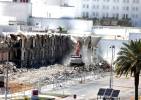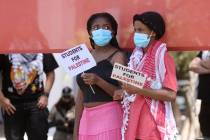UNLV sets sights high for medical school facility
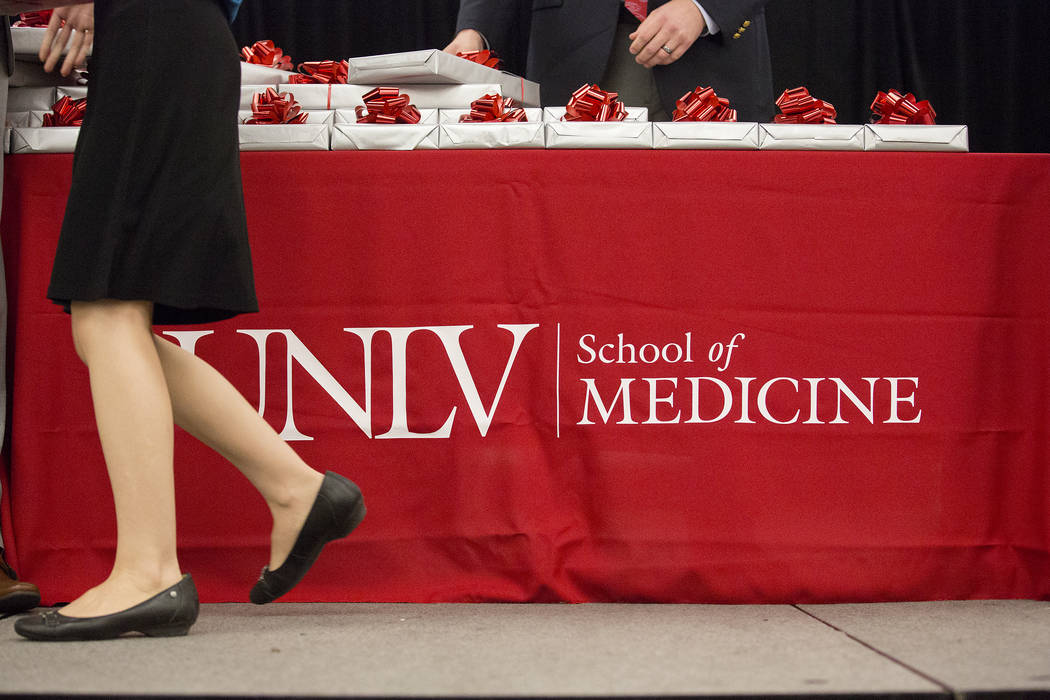
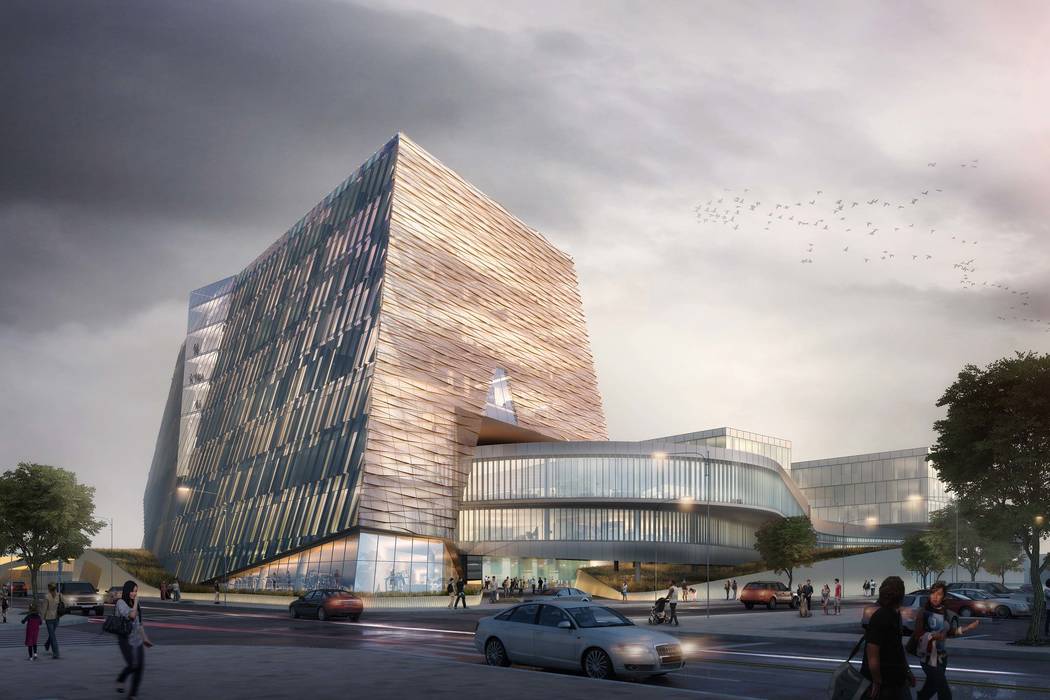
UNLV reported a record year of fundraising for fiscal year 2017.
The UNLV Foundation hauled in $93 million — nearly $20 million more than the previous year.
But one gift — a $25 million anonymous donation to the new medical school — took the total over the top.
“It’s great to hear they’ve raised $25 million,” said G. Robert Alsobrook, senior consulting vice president at Grenzebach Glier and Associates, and a consultant to the Association of American Medical Colleges. “Those who made those gifts represent the constituency the school can look to in its inaugural year as it builds relationships with others.”
The fundraising accomplishments can serve as the foundation for future successes, he said.
Much more is needed, however, before UNLV realizes its ultimate goal — a new medical education building.
‘We’re gonna go for it’
Raising big money for a big project — a specialized academic building that could cost $250 million — is a long and arduous process, said Scott Roberts, UNLV Foundation president.
The university hopes to open the facility by the spring of 2021 — a key time for the new school. That is when the Liaison Committee on Medical Education will likely decide whether the school receives full accreditation.
“Earlier is always more desirable, but it’s a key milestone we’ll keep in mind. We’re on target for that and possibly to beat that target,” said David Frommer, executive director for planning and construction at UNLV.
By comparison, Roberts noted, University of California, Riverside set a $250 million fundraising goal over 10 years.
“If you saw the type of money they’re (UC Riverside) raising compared to us, it’s really telling of the amount of support we’re getting from Las Vegas and the community to start a medical school,” Roberts said.
UNLV is looking at a “wide range” of options for its new medical education building, with the lowest figure coming in at $135 million.
But President Len Jessup and others want to aim higher, Roberts said.
“We realized we have a greater opportunity for the future of UNLV,” he said. “It’s an academic health center — not just a building.”
Roberts said the facility will include a medical library available to all students and buildings to house three schools in addition to the medical school: nursing, community health sciences and allied health sciences.
“We’ll truly integrate all of the health sciences onto that campus,” Roberts said. “We’re gonna go for it. We’re not going to think small.”
But raising $250 million is made more difficult with a non-existent pool of alumni. For example, only 4 percent of the money brought in by the foundation in fiscal year 2017 came from alumni, with the largest amount — 34 percent — coming from estates and trusts.
“This isn’t a thing that happens overnight,” Roberts said. “The one thing we have to keep in mind is that there currently are no alumni of our School of Medicine.”
UNLV itself is relatively young — another hurdle.
Arizona State University is one of UNLV’s aspirational peers, but it was founded 72 years before UNLV — in 1885. Arizona State also boasts a student population of more than 70,000 and approximately 400,000 alumni.
“This makes a big difference in fundraising, as you can imagine,” Roberts said.
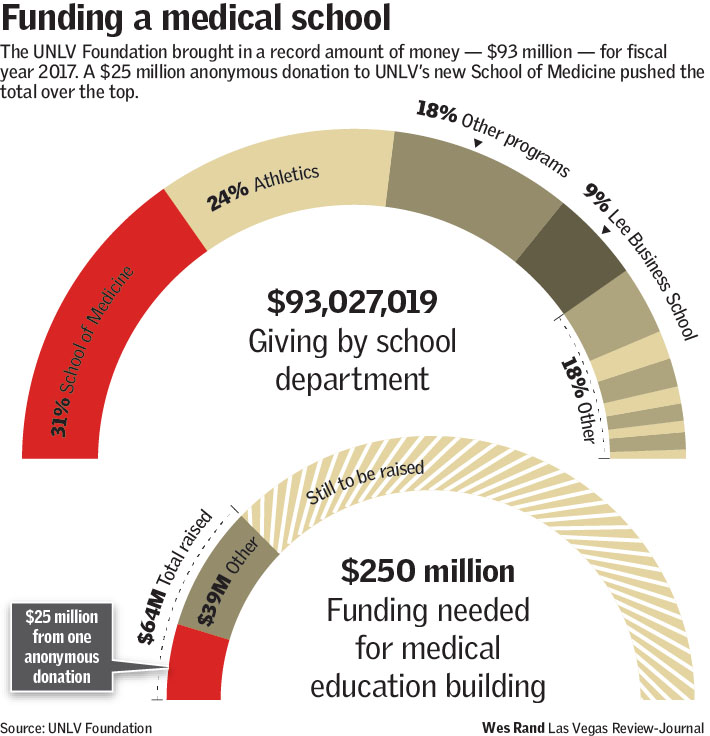
RIGHT-CLICK TO ENLARGE
‘Unprecedented’
The medical school’s fundraising achievements began in 2015 — two years prior to opening — with $13.5 million in donations to provide 135 full scholarships.
All 60 members of the charter class received the scholarships; 25 students each in the next three cohorts will receive the same.
“It’s unprecedented,” Roberts said. “What’s happened is truly remarkable. The excitement behind this is so strong.”
While the amount raised for scholarships might be unprecedented, the idea was taken from another of UNLV’s aspirational peers — the University of Central Florida. Central Florida’s College of Medicine provided free education to members of its inaugural class in 2009.
Focusing on fundraising for scholarships and a facility was top of mind for Central Florida’s leadership, said Deborah German, founding dean of the Central Florida’s College of Medicine. German said an impressive facility can attract great students and faculty, and scholarships can attract students who might not otherwise attend a program that is not fully accredited — which happens after the first class graduates.
“A new school is untested, unknown in quality until it graduates several classes and can show how well students are performing,” German said. “Communities and donors see it as a risk. It’s up to the leadership of the new school to inspire confidence of the community and donors until you can see the results.”
Alsobrook shared similar sentiments.
“There’s an image and visibility challenge that new medical schools face when it comes to establishing a presence and making a case for philanthropic support,” Alsobrook said.
Alsobrook said he’s heard of new medical schools aligning with volunteers and advocates who have influence in relationship building. The advocates could be well-known community figures and leaders, he said. It can also be benefit a medical school to leverage its position within the university for fundraising options.
And while a younger university like UNLV can suffer from a lack of chronological history, that can be a positive.
“A relatively new higher education institution can be the type of institution that’s viewed as dynamic, contemporary,” Alsobrook said. “It’s not gotten weighed down with things that are hurdles or obstructions, because of perceptions of how things have been done in the past.”
The vision displayed by a newer university can drum up the excitement needed for funding, he said.
“Many people can appreciate the opportunity for advancing medicine and science in your state and beyond by having another medical school in the state,” Alsobrook said. “There very well could be those who want to be philanthropic investors in that, in helping to build this new program.”
In addition to the $25 million anonymous donation, UNLV received a matching amount toward the building by the 2017 Nevada Legislature. Roberts said the school also recently was given $14 million for the building from the Englestad Family Foundation, bringing the total raised for the facility to $64 million.
The State Board of Examiners granted the university a postponement last month on a $500,000 pre-construction contract, which Frommer said will allow the university to continue focusing on current and potential donors. Frommer said UNLV wants to ensure that the project scope and budget are in alignment.
“The more alignment you can have with the project parameters at the front end, the better things go, and there’s less of a risk going forward,” Frommer said.
Roberts said 10 to 12 other major donors are looking to make gifts in the seven-to-eight figure range.
“The challenge we face is that donors are not on our timeline, we’re on their timeline,” Roberts said. “The last thing we want to do is rush it.”
Contact Natalie Bruzda at nbruzda@reviewjournal.com or 702-477-3897. Follow @NatalieBruzda on Twitter.




